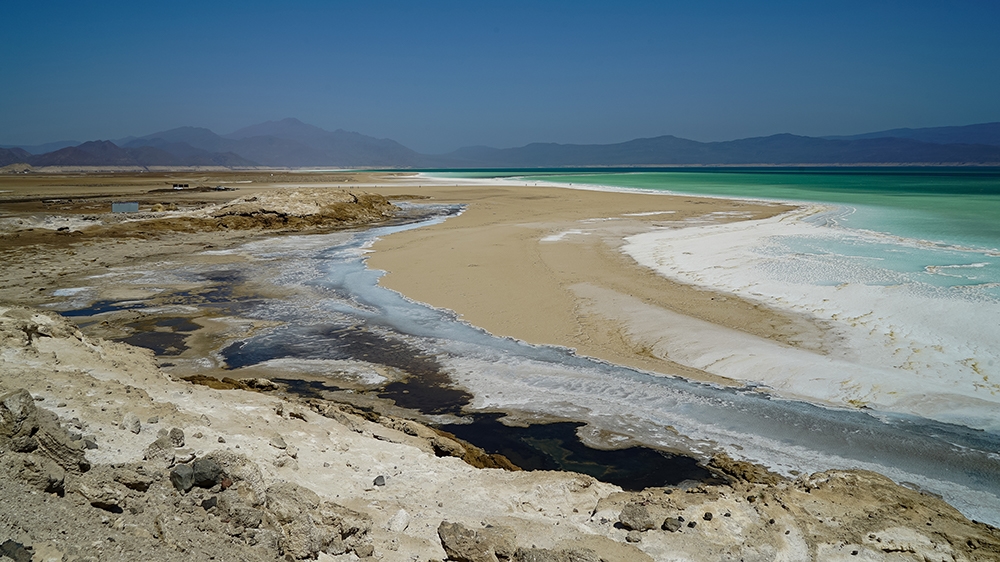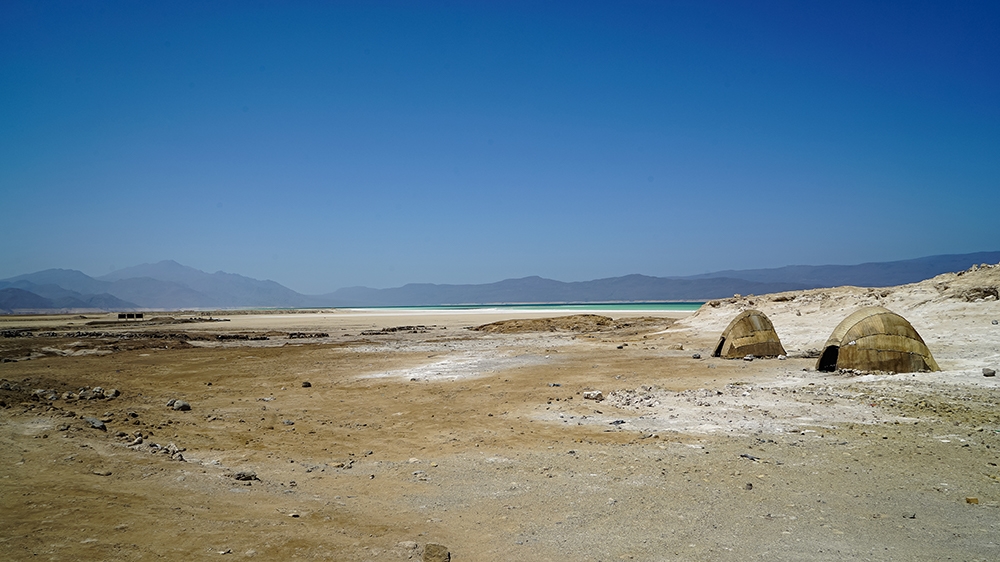Home to more than six million tonnes of salt, camel caravans still take the precious resource to Ethiopia.
From a distance, Djibouti‘s Lake Assal could be mistaken for a prime holiday destination.
Its waters glisten under the midday sun, sparkling in different shades of dark blue, turquoise and green.
In the distance, camel caravans carry payloads of goods into the desert, disappearing beyond the horizon.
But the closer you get to this place of unsurpassed beauty, the vast desert plains give rise to an altogether different landscape – a place where the sand is not actually sand at all.
Created a millennia ago by volcanic eruptions, the receding waters at Lake Assal have left behind an expanse of crystal white salt that is stunningly beautiful, but excruciatingly painful to walk upon barefoot.
The waters of the lake offer no respite either.
The warm and shallow waters sting the eyes and bite against the skin.
 |
| Lake Assal has been at the centre of the salt trade for centuries with salt caravans travelling back and forth to the Ethiopian Highlands [Faisal Edroos/Al Jazeera] |
Yet it’s here, every morning, that dozens of men Like Hummad Musa converge.
They toil away under the blistering hot sun and break the ground open with hand axes to extract salt, a trade which historians estimate has gone on since the sixth century.
Musa says most of this week’s labour has been mined just metres away from the shore and will be sold to the few tourists who visit this harsh, desolate place.
A relatively new country, Djibouti gained its independence from France just 41 years ago. But despite its young age, it’s the homeland of an ancient people who have lived and roamed the countryside for centuries.
Next week, Musa, a member of the Afar ethnic people, says he will take his caravan of 10 camels to markets across Ethiopia, a journey his father and grandfather once made.
“I’ve been working in this trade since I was a child,” the 63-year-old told Al Jazeera, as the oven-hot winds lashed against his face.
“We start work early in the morning and continue extracting the salt until Dhuhr prayers (midday).
“Whenever the tourists happen to visit, we come back (to the stalls on the shore) and sell them whatever we can to provide food and water for our families”.
 |
| Hummad Musa says most of the tourists that visit this desolate region simply take photos of the salt-encrusted skulls of antelopes and gazelles before leaving [Faisal Edroos/Al Jazeera] |
According to Musa, each of his camels will be carrying up to 150kg of the “white gold” for sale in Ethiopia.
The journey could take up to five weeks and will see the caravan make at least four stops – first in Debyie, then Barkato, Balhou, and finally Aile Da-ar.
If all goes well, a top-grade slab weighing 25kg will fetch around 10 Ethiopian birr, around $0.40.
With each camel carrying around $2.40 worth of salt, the entire caravan could make more than $20 – with his share enough to last his family of three more than a fortnight.
According to Musa, what sets his salt apart from the “white gold” found in Ethiopia’s northeastern Danakil Depression is the quality.
Lake Assal has an average salt concentration of 34 percent, making it nearly 10 times saltier than seawater.
At 155 metres below sea level, Assal is also the lowest point in Africa and the third lowest point in the world after the Sea of Galilee and the Dead Sea.
Wade into the waters, Musa says, and you’ll also find something, which can’t be found any anywhere else in the world – perfect spheres of salt.
 |
| The spheres of salt can vary in size from caviar eggs to small peaches [Faisal Edroos/Al Jazeera] |
Depending on the wind, each segment of the Lake’s shore produces its own shape and size, he says.
The spheres are formed entirely by nature when tiny crystals get glued together and roll around on the seabed. They slowly snowball before whittling and polishing themselves into perfect spheres.
Families work together, he says, with men wading deep into the lake to get the salt.
Later, the women hand sort the spheres by size, which can vary in size from caviar eggs to small peaches.
Musa says while the trade is relatively unknown in the west, Assal’s salt has not escaped the attention of Chinese mining companies.
With more than six million tonnes of salt being deposited in the area every year, and the thickness of Assal’s crust varying between 20 and 80 metres, a Chinese-funded industrial plant has started work. The government has also tabled the Lake Assal Salt Project to further commodify the lake.
 |
| Hummad Musa’s house is made of chicken wire and corrugated iron. It neither keeps the wind or the heat out [Faisal Edroos/Al Jazeera] |
But today, most of Musa’s daily business comes from tourists or the thousands of foreigners stationed at the United States’s, Chinese, Japanese, and French military bases in Djibouti.
“I’m flying back in a couple of weeks and my wife told me to bring back some novelty items,” said Carl, one of 4,000 Americans stationed at Camp Lemonnier.
“So the first place I thought of was here.
“I doubt my wife will use the salt to cook with but it sure will make for a good gift.”
A railway being built from Djibouti to Ethiopia has also raised fears that in the near future the traditional camel caravan route could be rendered obsolete.
But until then, Afar miners like Musa say they’ll continue their tough way of life, hacking away at the ground and eking out a living from this desolate stretch of salt.
 |
| Goubet Al-Kharab, referred to as the Island of the Devil, is just 20km from Lake Assal [Faisal Edroos/Al Jazeera] |




























